Leave No Trace

Layday is stoked to be part of the Leave No Trace community.
We've teamed up with LNT to share their simple messages and principles about travelling in the outdoors.
These 7 pointers are mostly common sense, but it's worth scrolling through these best practices.
Principle 1: Plan Ahead and Prepare
Adequate trip planning and preparation helps backcountry travelers accomplish trip goals safely and enjoyably, while simultaneously minimising damage to the land.
PRE-TRIP PLANNING
Poor planning often results in miserable campers and damage to natural and cultural resources. Rangers often tell stories of campers they have encountered who, because of poor planning and unexpected conditions, degrade backcountry resources and put themselves at risk.
WHY IS TRIP PLANNING IMPORTANT?
You may want to create additional answers for this list:
- It helps ensure the safety of groups and individuals.
- It prepares you to Leave No Trace and minimizes resource damage.
- It contributes to accomplishing trip goals safely and enjoyably.
- It increases self-confidence and opportunities for learning more about nature.
SEVEN ELEMENTS TO CONSIDER WHEN PLANNING A TRIP
- Identify and record the goals (expectations) of your trip.
- Identify the skill and ability of trip participants.
- Select destinations that match your goals, skills, and abilities.
- Gain knowledge of the area you plan to visit from land managers, maps, and literature.
- Choose equipment and clothing for comfort, safety, and Leave No Trace qualities.
- Plan trip activities to match your goals, skills, and abilities.
- Evaluate your trip upon return note changes you will make next time.
OTHER ELEMENTS TO CONSIDER
- Weather
- Terrain
- Regulations/restrictions
- Private land boundaries
- Average hiking speed of group n anticipated food consumption (leftovers create waste which leaves a trace!)
- Group size (does it meet regulations, trip purpose and Leave No Trace criteria?)
Meals are another element to trip planning that can have a profound effect on the impact a group has on a backcountry area.
Benefits of Good Meal Planning:
- Reduced trash.
- Reduced pack weight, resulting in faster hiking times and less fatigue.
- Reduced dependence upon campfires for cooking.
- One-Pot Meals and Food Repackaging
Planning for one-pot meals and light weight snacks requires a minimum of packing and preparation time, lightens loads and decreases garbage. One-pot meals require minimal cooking utensils and eliminate the need for a campfire. Two backpack stoves can be used to cook all meals for large groups if you have two large pots (one large pot can be balanced on two stoves when quick heating is desired). Remember, a stove Leaves No Trace.
Most food should be removed from its commercial packing and placed in sealable bags before packing your backpacks. Sealable bags secure food and reduce bulk and garbage. Empty bags can be placed inside each other and packed out for reuse at home. This method can reduce the amount of garbage your group must pack out at the end of the trip and eliminate the undesirable need of stashing or burying unwanted trash.
What are Some Examples of the Results of Poor Trip Planning?
A group that is inexperienced or unfamiliar with the geography of an area may put people at risk by traveling through areas susceptible to flash floods or along ridge tops vulnerable to lightning activity. Groups traveling arid lands often fail to carry adequate water or a way of purifying water from natural sources. Checking with local land managers and studying maps and weather conditions can contribute to a low-risk existence.
A poorly prepared group may plan to cook meals over a campfire only to discover upon arrival at their destination that a fire ban is in effect or that firewood is in scarce supply. Such groups often build a fire anyway breaking the law or impacting the land simply because they have not planned for alternatives. Fire bans and scarce wood supplies are signs that an area is experiencing the cumulative effects of heavy recreation use.
A group that has failed to develop good travel plans may be unable to travel as fast as expected. The terrain may be too steep or the trails too rugged. These groups often resort to setting up camp late at night, sometimes in an unsafe location. Poor campsite selection usually leads to unnecessary resource damage. In addition, the group may never even reach their planned destination.
Principle 2: Travel and Camp on Durable Surfaces
The goal of backcountry travel is to move through the backcountry while avoiding damage to the land. Understanding how travel causes impacts is necessary to accomplish this goal.
Travel damage occurs when surface vegetation or communities of organisms are trampled beyond recovery. The resulting barren area leads to soil erosion and the development of undesirable trails. Backcountry travel may involve travel over both trails and off-trail areas.
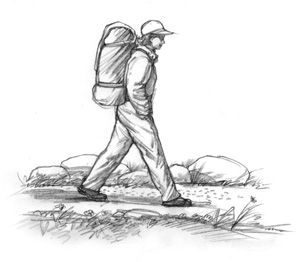
TRAVEL ON TRAILS
Concentrate Activities When Traveling in Heavily Used Areas Land management agencies construct trails in backcountry areas to provide identifiable routes that concentrate foot and stock traffic. Constructed trails are themselves an impact on the land; however, they are a necessary response to the fact that people travel in the back country. Concentrating travel on trails reduces the likelihood that multiple routes will develop and scar the landscape. It is better to have one well-designed route than many poorly chosen paths.
Trail use is recommended whenever possible. Encourage travelers to stay within the width of the trail and not short cut trail switchbacks (trail zigzags that climb hill sides). Travelers should provide space for other hikers if taking breaks along the trail. The principles of off-trail travel should be practiced if the decision is made to move off-trail for breaks.
(Hikers in the same group should periodically stop to rest and talk. Avoid shouting to communicate while hiking. Loud noises usually are not welcome in natural areas.)
TRAVEL OFF-TRAIL
Spread Use and Impact in Pristine Areas (except in some desert areas) All travel that does not utilize a designed trail such as travel to remote areas, searches for bathroom privacy, and explorations near and around campsites is defined as off-trail. Two primary factors increase how off-trail travel affects the land: durability of surfaces and vegetation, and frequency of travel (or group size).
Durability refers to the ability of surfaces or vegetation to withstand wear or remain in a stable condition.
Frequency of use and large group size increase the like hood that a large area will be trampled, or that a small area will be tram pled multiple times.
SURFACE DURABILITY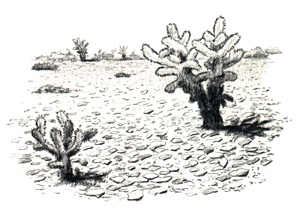
The concept of durability is an important one for all backcountry travelers to understand. The following natural surfaces respond differently to backcountry travel.
Rock, sand and gravel: These surfaces are highly durable and can tolerate repeated trampling and scuffing. (However, lichens that grow on rocks are vulnerable to repeated scuffing).
Ice and snow: The effect of travel across these surfaces is temporary, making them good choices for travel assuming good safety precautions are followed and the snow layer is of sufficient depth to prevent vegetation damage.
Vegetation: The resistance of vegetation to trampling varies. Careful decisions must be made when traveling across vegetation. Select areas of durable vegetation, or sparse vegetation that is easily avoided. Dry grasses tend to be resistant to trampling. Wet meadows and other fragile vegetation quickly show the effects of trampling. Trampling ensures new travelers to take the same route and leads to undesirable trail derailment. As a general rule, travelers who must venture off-trail should spread out to avoid creating paths that encourage others to follow. Avoid vegetation whenever possible, especially on steep slopes where the effects of off-trail travel are magnified.
Cryptobiotic crust ("Crypto"): Cryptobiotic crust, found in desert environments, is extremely vulnerable to foot traffic. Cryptobiotic crust consists of tiny communities of organisms that appear as a blackish and irregular raised crust upon the sand. This crust retains moisture in desert climates and provides a protective layer, preventing erosion. One footstep can destroy "crypto". It is important to use developed trails in these areas. Travel across "crypto" should only be done when absolutely necessary. Walk on rocks or other durable surfaces if you must travel off-trail. In broad areas of "crypto", where damage is unaviodable, it is best to follow in one anothers foot steps so the smallest area of crust is affected, exactly the opposite rule from travel through vegetation. (Cryptobiotic crust is also extremely vulnerable to mountain bicycle travel.)
Desert puddles and mud holes: Water is a preciously scarce resource for all living things in the desert. Don't walk through desert puddles, mud holes, or disturb surface water in any way. Potholes are also home to tiny desert animals.
CAMP ON DURABLE SURFACES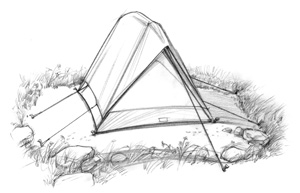
Selecting an appropriate campsite is perhaps the most important aspect of low-impact backcountry use. It requires the greatest use of judgment and information and often involves making trade-offs between minimizing ecological and social impacts. A decision about where to camp should be based on information about the level and type of use in the area, the fragility of vegetation and soil, the likelihood of wildlife disturbance, an assessment of previous impacts, and your party s potential to cause or avoid impact.
CHOOSING A CAMPSITE IN HIGH-USE AREAS
Avoid camping close to water and trails and select a site which is not visible to others. Even in popular areas the sense of solitude can be enhanced by screening campsites and choosing an out-of-the-way site. Camping away from the water's edge also allows access routes for wild life. Be sure to obey regulations related to campsite selection. Allow enough time and energy at the end of the day to select an appropriate site. Fatigue, bad weather, and late departure times are not acceptable excuses for choosing poor or fragile camp sites.
Generally, it is best to camp on sites that are so highly impacted that further careful use will cause no noticeable impact. In popular areas, these sites are obvious because they have already lost their vegetation cover. Also, it is often possible to find a site which naturally lacks vegetation, such as exposed bedrock or sandy areas.
On high-impact sites, tents, traffic routes, and kitchen areas should be concentrated on already impacted areas. The objective is to confine impact to places which already show use and avoid enlarging the area of disturbance. When leaving camp, make sure that it is clean, attractive, and appealing to other campers who follow.
CAMPING IN UNDISTURBED REMOTE AREAS
Pristine areas are usually remote, see few visitors, and have no obvious impacts. Visit these special places only if you are committed to, and highly skilled in, Leave No Trace techniques.
In pristine sites it is best to spread out tents, avoid repetitive traffic routes, and move camp every night. The objective is to minimize the number of times any part of the site is trampled. In setting up camp, disperse tents and the kitchen on durable sites. Wear soft shoes around camp. Minimize activity around the kitchen and places where packs are stashed. The durable surfaces of large rock slabs make good kitchen sites. Watch where you walk to avoid crushing vegetation and take alternate paths to water. Minimize the number of trips to water by carrying water containers. Check regulations, but camping 200 feet (70 adult steps) from water is a good rule of thumb.
When breaking camp, take time to naturalize the site. Covering scuffed areas with native materials (such as pine needles), brushing out footprints, and raking matted grassy areas with a stick will help the site recover and make it less obvious as a campsite. This extra effort will help hide any indication where you camped and make it less likely that other backcountry travelers will camp in the same spot. The less often a pristine campsite is used the better chance it has of remaining pristine. Camping in Arid Lands The most appropriate campsites in arid lands are on durable surfaces, such as rock and gravel, or on sites that have been so highly impacted further use will cause no additional disturbance. Previously impacted sites are obvious because they have already lost their vegetation cover or the rocky soils have been visibly disturbed. If choosing this type of site, make sure your spot is large enough to accommodate your entire group.
A pristine campsite, with no evidence of previous use, is appropriate in arid lands provided it is on a non-vegetated, highly resistant surface. Expanses of rock, gravel or sand are all excellent choices. It should never be necessary to camp on cryptobiotic soil, islands of vegetation, or within the precious green ribbons of desert creeks or streams. Beware when camping on sandy river bottoms and areas susceptible to flash floods.
Cooking areas, tents and backpacks should be located on rock, sand, or gravel. Conscious y choose durable routes of travel between parts of your camp so that connecting trails do not develop. Vary your routes since the objective is to minimize the amount of trampling and compaction on any specific part of the campsite. Limit your stay to no more than two nights.
Never scrape away or clean sites of organic litter like leaves, and always minimize the removal of rocks and gravel. The organic litter will help to cushion trampling forces, limit the compactability of soils, release plant nutrients, and reduce the erosive forces of rainfall. Disturbing the lichen-coated and varnished rocks known as desert pavement can leave a visible impact for hundreds of years. Once overturned, these rocks are difficult to replace and the lichens and varnish will not grow back within our lifetime.
CAMPING IN RIVER CORRIDORS
River corridors are narrow strips of land and water with little room to disperse human activities. Campsites are often designated. It is generally best to camp on established sites located on beaches, sandbars, or non-vegetated sites below the high-water line.
Principle 3: Dispose of Waste Properly
HUMAN WASTE
Proper disposal of human waste is important to avoid pollution of water sources, avoid the negative implications of someone else finding it, minimize the possibility of spreading disease, and maximize the rate of decomposition.
In most locations, burying human feces in the correct manner is the most effective method to meet these criteria. Solid human waste must be packed out from some places, such as narrow river canyons. Land management agencies can advise you of specific rules for the area you plan to visit.
Contrary to popular opinion, research indicates that burial of feces actually slows decomposition (at least in the Rocky Mountains). Pathogens have been discovered to survive for a year or more when buried. However, in light of the other problems associated with feces, it is still generally best to bury it. The slow decomposition rate causes the need to choose the correct location, far from water, campsites, and other frequently used places.
CATHOLES
Catholes are the most widely accepted method of waste disposal. Locate catholes at least 200 feet (about 70 adult steps) from water, trails and camp. Select an inconspicuous site where other people will be unlikely to walk or camp. With a small garden trowel, dig a hole 6-8 inches deep and 4-6 inches in diameter. The cathole should be covered and disguised with natural materials when finished. If camping in the area for more than one night, or if camping with a large group, cathole sites should be widely dispersed.
Perhaps the most widely accepted method of backcountry human waste disposal is the cathole. The advantages are:
- they are easy to dig in most areas.
- they are easy to disguise after use.
- they are private.
- they disperse the waste rather than concentrate it (which enhances decomposition).
- it is usually easy to select an out of the way location where you can be certain no one is going to casually encounter the cathole.
SELECTING A CATHOLE SITE:
- Select a cathole site far from water sources, 200 feet (approximately 70 adult paces) is the recommended range.
- Select an inconspicuous site untraveled by people. Examples of cathole sites include thick undergrowth, near downed timber, or on gentle hillsides.
- If camping with a group or if camping in the same place for more than one night, disperse the catholes over a wide area; don't go to the same place twice.
- Try to find a site with deep organic soil. This organic matter contains organisms which will help decompose the feces. (Organic soil is usually dark and rich in color.) Refer to the jars used to demonstrate decomposition. The desert does not have as much organic soil as a forested area. (See number 2 under Digging a Cathole below.)
- If possible, locate your cathole where it will receive maximum sunlight. The heat from the sun will aid decomposition.
- Choose an elevated site where water would not normally go during runoff or rain storms. The idea here is to keep the feces out of water. Over time, the decomposing feces will percolate into the soil before reaching water sources.
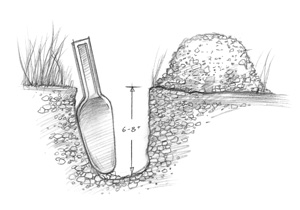
DIGGING A CATHOLE
- A small garden trowel is the perfect tool for digging a cathole.
- Dig the hole 6-8 inches deep (about the length of the trowel blade) and 4-6 inches in diameter. In a hot desert, human waste does not biodegrade easily because there is littleorganicsoil to help break it down. In the desert, the cathole should be only 4-6 inches deep. This will allow the heat and sun to hasten the decay process.
- When finished, the cathole should be filled with the original dirt and disguised with native materials.
CATHOLES IN ARID LANDS
- A cathole is the most widely accepted means of waste disposal in arid lands. Locate catholes at least 200 feet (about 70 adult steps) from water, trails, and camp. Avoid areas where water visibly flows, such as sandy washes, even if they are dry at the moment. Select a site that will maximize exposure to the sun in order to aid decomposition. Because the sun's heat will penetrate desert soils several inches, it can eventually kill pathogens if the feces are buried properly. South-facing slopes and ridge tops will have more exposure to sun and heat than other areas.
LATRINES
Though catholes are recommended for most situations, there are times when latrines may be more applicable, such as when camping with young children or if staying in one camp for longer than a few nights. Use similar criteria for selecting a latrine location as those used to locate a cathole. Since this higher concentration of feces will decompose very slowly, location is especially important. A good way to speed decomposition and diminish odors is to toss in a handful of soil after each use. Ask your land manager about latrine-building techniques.
TOILET PAPER
Use toilet paper sparingly and use only plain, white, non-perfumed brands. Toilet paper must be disposed of properly! It should either be thoroughly buried in a cathole or placed in plastic bags and packed out. Natural toilet paper has been used by many campers for years. When done correctly, this method is as sanitary as regular toilet paper, but without the impact problems. Popular types of natural toilet paper include stones, vegetation and snow. Obviously, some experimentation is necessary to make this practice work for you, but it is worth a try! Burning toilet paper in a cathole is not generally recommended.
Toilet Paper in Arid Lands: Placing toilet paper in plastic bags and packing it out as trash is the best way to Leave No Trace in a desert environment. Toilet paper should not be burned. This practice can result in wild fires.
TAMPONS
Proper disposal of tampons requires that they be placed in plastic bags and packed out. Do not bury them because they don't decompose readily and animals may dig them up. It will take a very hot, intense fire to burn them completely.
URINE
Urine has little direct effect on vegetation or soil. In some instances urine may draw wildlife which are attracted to the salts. They can defoliate plants and dig up soil. Urinating on rocks, pine needles, and gravel is less likely to attract wildlife. Diluting urine with water from a water bottle can help minimize negative effects.
Special Considerations for River Canyons: River canyons often present unique Leave No Trace problems. The most common practice is to urinate directly in the river and pack out feces in sealed boxes for later disposal. Check with your land manager for details about specific areas.
Principle 4: Leave What You Find
Allow others a sense of discovery by leaving rocks, plants, archaeological artifacts and other objects of interest as you find them. The activities for this Leave No Trace principle deal with cultural artifacts; however, leave what you find involves many aspects of outdoor use. The following information addresses a variety of ways to respect natural settings.
MINIMIZE SITE ALTERATIONS
Leave areas as you found them. Do not dig trenches for tents or construct lean-tos, tables, chairs, or other rudimentary improvements. If you clear an area of surface rocks, twigs or pine cones, replace these items before leaving. On high impact sites, it is appropriate to clean up the site and dismantle inappropriate user-built facilities, such as multiple fire rings and constructed seats or tables. Consider the idea that good campsites are found and not made.
In many locations, properly located and legally constructed facilities, such as a single fire ring, should be left. Dismantling them will cause additional impact because they will be rebuilt with new rocks and thus impact a new area. Learn to evaluate all situations you find.
AVOID DAMAGING LIVE TREES AND PLANTS
Avoid hammering nails into trees for hanging things, hacking at them with hatchets and saws, or tying tent guy lines to trunks, thus girdling the tree. Carving initials into trees is unacceptable. The cutting of boughs for use as sleeping pads creates minimal benefit and maximum impact. Sleeping pads are available at stores catering to campers.
Picking a few flowers does not seem like it would have any great impact and, if only a few flowers were picked, it wouldn't. But, if every visitor thought "I'll just take a few", a much more significant impact might result. Take a picture or sketch the flower instead of picking it. Experienced campers may enjoy an occasional edible plant, but they are careful not to deplete the surviving vegetation or disturb plants that are rare or are slow to reproduce.
LEAVE NATURAL OBJECTS AND CULTURAL ARTIFACTS
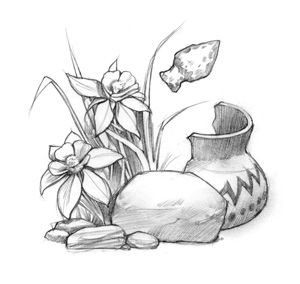 Natural objects of beauty or interest such as antlers, petrified wood, or colored rocks add to the mood of the backcountry and should be left so others can experience a sense of discovery. In National Parks and some other areas it is illegal to remove natural objects.
Natural objects of beauty or interest such as antlers, petrified wood, or colored rocks add to the mood of the backcountry and should be left so others can experience a sense of discovery. In National Parks and some other areas it is illegal to remove natural objects.
The same ethic is applicable to cultural artifacts found on public land. Cultural artifacts are protected by the Archaeological Resources Protection Act. It is illegal to remove or disturb archeological sites, historic sites, or artifacts such as pot shards, arrowheads, structures, and even antique bottles found on public lands.
Principle 5: Minimize Campfire Impacts
Fires vs. Stoves: The use of campfires, once a necessity for cooking and warmth, is steeped in history and tradition. Some people would not think of camping without a campfire. Campfire building is also an important skill for every camper. Yet, the natural appearance of many areas has been degraded by the overuse of fires and an increasing demand for firewood. The development of light weight efficient camp stoves has encouraged a shift away from the traditional fire. Stoves have be come essential equipment for minimum-impact camping. They are fast, flexible, and eliminate firewood availability as a concern in campsite selection. Stoves operate in almost any weather condition, and they Leave No Trace.
SHOULD YOU BUILD A FIRE?
- The most important consideration to be made when deciding to use a fire is the potential damage to the backcountry.
- What is the fire danger for the time of year and the location you have selected? n Are there administrative restrictions from the agency that administers the area?
- Is there sufficient wood so its removal will not be noticeable?
- Does the harshness of alpine and desert growing conditions for trees and shrubs mean that the regeneration of wood sources cannot keep pace with the demand for firewood?
- Do group members possess the skill to build a campfire that will Leave No Trace?
LESSENING IMPACTS WHEN CAMPFIRES ARE USED
Camp in areas where wood is abundant if building a fire. Choose not to have a fire in areas where there is little wood at higher elevations, in heavily used areas, or in desert settings. A true Leave No Trace fire shows no evidence of having been constructed.
EXISTING FIRE RINGS
The best place to build a fire is within an existing fire ring in a well-placed campsite. Keep the fire small and burning only for the time you are using it. Allow wood to burn completely to ash. Put out fires with water, not dirt. Dirt may not completely extinguish the fire. Avoid building fires next to rock out crops where the black scars will remain for many years.
MOUND FIRE
Construction of a mound fire can be accomplished by using simple tools: a garden trowel, large stuff sack and a ground cloth or plastic garbage bag.
To build this type of fire:
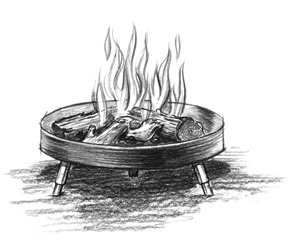
Collect some mineral soil, sand, or gravel from an already disturbed source. The root hole of a toppled tree is one such source. Lay a ground cloth on the fire site and then spread the soil into a circular, flat-topped mound at least 3 to 5 inches thick. The thickness of the mound is critical to insulate the ground below from the heat of the fire. The ground cloth or garbage bag is important only in that it makes clean
ing up the fire much easier. The circumference of the mound should be larger than the size of the fire to allow for the spreading of coals. The advantage of the mound fire is that it can be built on flat exposed rock or on an organic surface such as litter, duff or grass.
FIRE PANS
Use of a fire pan is a good alternative for fire building. Metal oil drain pans and some backyard barbecue grills make effective and inexpensive fire pans. The pan should have at least three-inch-high sides. It should be elevated on rocks or lined with mineral soil so the heat does not scorch the ground.
FIREWOOD AND CLEANUP
Standing trees, dead or alive, are home to birds and insects, so leave them intact. Fallen trees also provide bird and animal shelter, increase water holding capacity of the soil, and recycle nutrients back into the environment through decomposition. Stripping branches from standing or fallen trees also detracts from an area's natural appearance.
- Avoid using hatchets, saws, or breaking branches off standing or downed trees. Dead and down wood burns easily, is easy to collect and leaves less impact.
- Use small pieces of wood no larger than the diameter of an adult wrist that can be broken with your hands.
- Gather wood over a wide area away from camp. Use dry drift wood on rivers and sea shores.
- Don't bring firewood from home. Either buy it from a local source or gather it responsibly where allowed.
- Burn all wood to white ash, grind small coals to ash between your gloved hands, thoroughly soak with water, and scatter the remains over a large area away from camp. Ashes may have to be packed out in river corridors.
- Replace soil where you found it when cleaning up a mound or pan fire.
- Scatter unused wood to keep the area as natural looking as possible.
- Pack out any campfire litter. Plastic items and foil-lined wrappers should never be burned in a camp fire.
SAFETY
- Provide adequate supervision for young people when using stoves or fires.
- Follow all product and safety labels for stoves.
- Use approved containers for fuel.
- Never leave a fire unattended.
- Keep wood and other fuel sources away from fire.
- Thoroughly extinguish all fires.
Principle 6: Respect Wildlife
Learn about wildlife through quiet observation. Do not disturb wildlife or plants just for a "better look". Observe wildlife from a distance so they are not scared or forced to flee. Large groups often cause more damage to the environment and can disturb wildlife so keep your group small. If you have a larger group, divide into smaller groups if possible to minimize your impacts.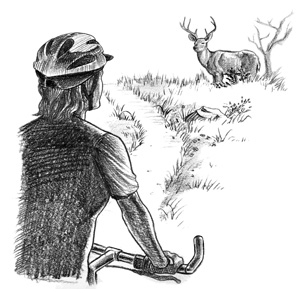
Quick movements and loud noises are stressful to animals. Travel quietly and do not pursue, feed or force animals to flee. (One exception is in bear country where it is good to make a little noise so as not to startle the bears) In hot or cold weather, disturbance can affect an animals ability to withstand the rigorous environment. Do not touch, get close to, feed or pick up wild animals. It is stressful to the animal, and it is possible that the animal may harbor rabies or other diseases. Sick or wounded animals can bite, peck or scratch and send you to the hospital. Young animals removed or touched by well-meaning people may cause the animals parents to abandon them. If you find sick animals or animal in trouble, notify a game warden.
Considerate campers observe wildlife from afar, give animals a wide berth, store food securely, and keep garbage and food scraps away from animals. Remember that you are a visitor to their home.
Allow animals free access to water sources by giving them the buffer space they need to feel secure. Ideally, camps should be located 200 feet or more from existing water sources. This will minimize disturbance to wildlife and ensure that animals have access to their precious drinking water. By avoiding water holes at night, you will be less likely to frighten animals because desert dwellers are usually most active after dark. With limited water in arid lands, desert travelers must strive to reduce their impact on the animals struggling for survival.
Washing and human waste disposal must be done carefully so the environment is not polluted, and animals and aquatic life are not injured. Swimming in lakes or streams is OK in most instances but in desert areas, leave scarce water holes undisturbed and unpolluted so animals may drink from them.
Principle 7: Be Considerate of Other Visitors
One of the most important components of outdoor ethics is to maintain courtesy toward other visitors. It helps everyone enjoy their outdoor experience.
Many people come to the outdoors to listen to nature. Excessive noise, unleashed pets and damaged surroundings take away from everyone's experience. So, keep the noise level down while traveling and if you bring a radio, tapes or CDs, use headphones so you will not disturb others. Also keep in mind that the feeling of solitude, especially in open areas, is enhanced when group size is small, contacts are infrequent and behavior is unobtrusive. To maximize your feeling of privacy, avoid trips on holidays and busy weekends or take a trip during the off season. Groups leading or riding livestock have the right-of-way on trails. Hikers and bicyclists should move off the trail to the downhill side. Talk quietly to the riders as they pass, since horses are spooked easily. Take rest breaks on durable surfaces well off the designated trail. Keep in mind that visitors to seldom used places require an extra commitment to travel quietly and lightly on the land. When selecting a campsite, choose a site where rocks or trees will screen it from others view. Keep noise down in camp so not to disturb other campers or those passing by on the trail. "Goofing off" or "pranks" are undesirable social behavior and may lead to serious or fatal injuries. Also "events" need to fit the setting - save game playing for the city park. Bright clothing and equipment, such as tents can be seen for long distances are discouraged. Especially in open natural areas, colors such as day-glow yellow are disturbing and contribute to a crowded feeling; choose earth-toned colors (ie. browns and greens) to lessen visual impacts.
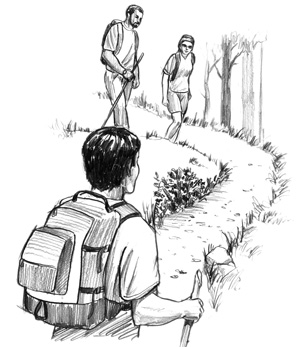 Stay in control when mountain biking. Before passing others, politely announce your presence and proceed with caution.
Stay in control when mountain biking. Before passing others, politely announce your presence and proceed with caution.
Keep pets under control at all times. Bowser is not in the wildlife category. Dogs running free can be unwelcome, frightening people or leaving behind unwanted "presents". Please pick up dog feces from camps and trails. Some areas prohibit dogs or require them to be on a leash at all times.
Leave gates as you find them, and leave the land undisturbed for others to enjoy. Remember, our open spaces and wildlands are protected for all generations. It is up to us to keep them healthy, beautiful and open to the public for recreation, reflection and revitalization! Enjoy and learn from historical and archeological sites but respect these sites and treasures. Some of these are sacred to Native Americans, or are important cultural reminders of our heritage.

